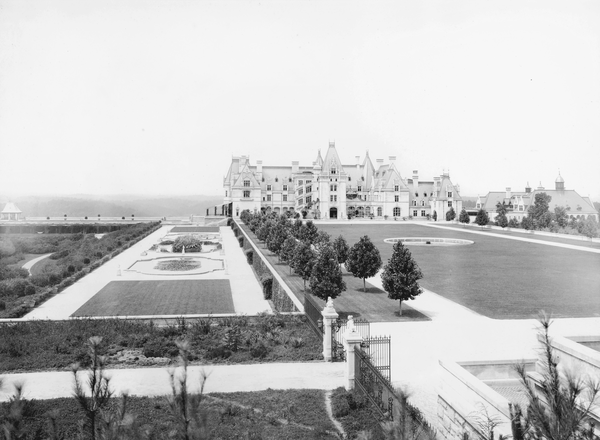Grand estates conjure up romantic images of ornate architecture, garden parties, lavish balls, and perfectly manicured gardens. The Biltmore Estate in the Blue Ridge Mountains in Asheville, North Carolina is no exception. Encompassing a total area of 8,000 acres, this privately-owned estate, owned by the Vanderbilt family for over 100 years, includes all those features, and more.
Building a legacy
The name “Biltmore” reflects the family’s Dutch ancestry and the local Asheville rural surroundings — Vanderbilt’s ancestors originated from “Bildt” in Holland.
Originally constructed as a country home by George Vanderbilt, grandson of entrepreneur and industrialist Cornelius Vanderbilt, “The House” is an expansive 250-room French chateau in gothic design. Construction took six years to complete from 1889 to 1895, involving a workforce of around 1,000 people.
The footprint of the house covers the expanse of four football fields. A forerunner for the times, the development included electricity, central heating, running water, and functional bathrooms.
George’s vision of creating a self-sustaining working estate, modeled along the lines of those in Europe, to provide an aristocratic lifestyle and employment for the local community, has continued to the present day.
During the construction of the main house, the large and productive Biltmore Nursery provided revenue from horticulture. The Main Dairy and Horse Barn, built soon after, supported the estate and staff with a working farm while development of the estate continued.
Members of the extended Vanderbilt family and esteemed and noteworthy guests privately enjoyed the opulence of the estate for the first few decades of the early 20th century.

Following George’s early death at age 51 in 1914, his wife, Edith, sold a large portion of the original landholding to the government — 87,000 acres — to preserve in a natural forestry state, following his intentions for the acreage. Over the next few years, selected properties were sold from the estate, including the Biltmore Village
With the economic downturn of the Great Depression, George’s daughter, Cornelia, opened the house and grounds to the public for the first time in 1930. This helped generate additional income from tour groups, a practice of many large estates in Europe and England at the time. Closed during World War II, Biltmore’s rooms secretly hid valuable art and portraits for the National Gallery.
From grapevines originally planted on the estate in the early 1970s by George Vanderbilt’s grandson, George Cecil, the Biltmore Estate Wine Company now handcrafts and bottles a range of fine wines.
Wine production began on the estate in the early 1980s, and it regularly receives accolades and awards. Since the early 2000s, new developments on the estate have included hospitality ventures such as Antler Hill Village in 2010 and the Village Hotel, completed in 2015.
The Biltmore estate continues to be a popular tourist attraction, event venue, and productive working estate today.
A Biltmore Christmas
In 1895, George Vanderbilt celebrated the completion of Biltmore’s construction by declaring the house officially open to guests with festivities and ornate decorations on Christmas Eve. The Banquet Hall was the central location for the Vanderbilt family celebrations during the Christmas and New Year periods, with a gigantic Christmas tree and stockings hung from the hearth.
Upholding the precedence of a decadent holiday season set by George Vanderbilt continues to be a feature of the Biltmore estate. Experience Christmas traditions the Vanderbilt way from November to early January and delight in storytelling, singing, candlelight evenings, gingerbread houses, decorative mantels, and festive hearths.
Conservation, Environmentalism and Sustainability
From the very beginning, George Vanderbilt and his landscape architect, Frederick Olmsted – the co-designer of Central Park in New York – planned and planted the Biltmore estate with conservation and regeneration in mind. Care and consideration towards George’s appreciation of the environment and self-sustainability are integral to the running of the estate.
The pedigree of the cattle farmed on the estate trace back to the original herd. The estate also farms, according to Global Animal Partnership guidelines, other livestock such as sheep, pigs, and chickens. Produce and vegetables grown on the working farm supply the estate’s kitchens and restaurants, and it supports the local community by purchasing other products locally.
In 2008, a magnolia tree planted by George and Edith on the birth of their daughter Cornelia in 1900 fell into decay. In its place stands a second-generation magnolia, self-seeded from the original. They recovered wood from the first tree and built gorgeous tabletops for the event rooms on the estate.
The Biltmore estate continues to innovate and receive awards for eco-friendly initiatives such as solar panels. The stunning historical site dedicated six acres to generating electricity, tree protection, and landscape design.
For over a hundred years, the Biltmore continues to set the gold standard for stunning architecture, conservation, and innovative ways to serve the community. The holiday season is the perfect time to enjoy this masterful American estate!

